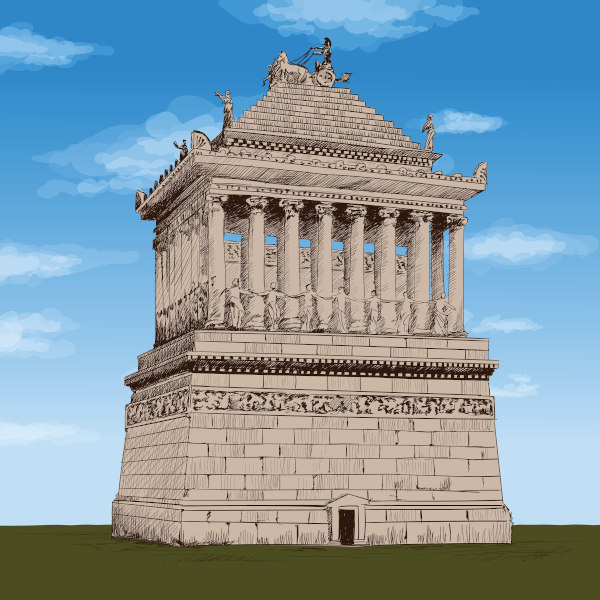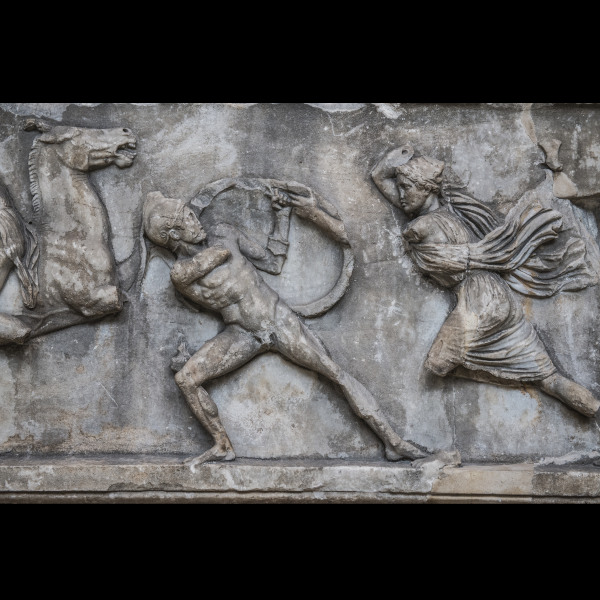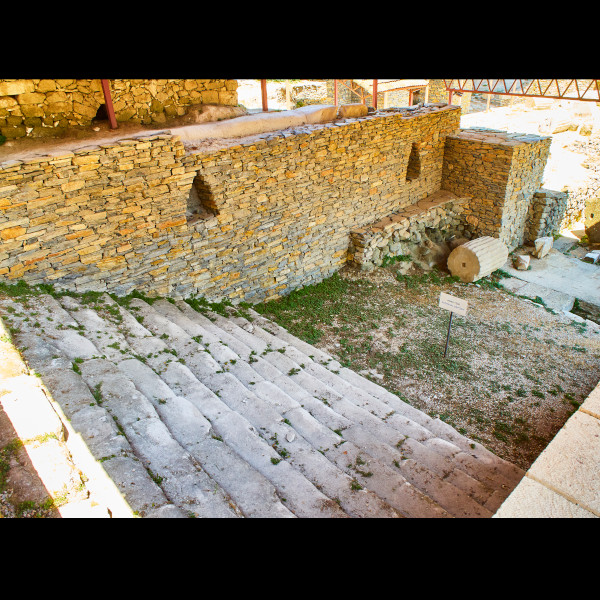DNA spotlight
The Mausoleum at Halikarnassos
Halikarnassos was an ancient Dorian Greek city in Anatolia - today known as the coastal city of Bodrum in Turkey. In this city stood one of the Seven Wonders of the Ancient World - The Mausoleum of Halikarnassos. Unlike most other Greek city states, Halikarnassos retained a monarchy. The city was a Dorian colony - founded by one of the four main ethnic groups of Classical Greece. This is evidenced by the coins depicting the head of Medusa, Athena or Poseidon which suggests the mother cities were Troezen and Argos in the Peleponnese. King Mausoleus became ruler of the larger state of Caria and moved its capital to Halikarnassos. He began many construction works including a massive foritified palace on one side of the harbor with clear views out to sea and inland to the hills.

Mausolus and his sister, wife and successor Artemisia began embellishing the city with statues, temples and buildings of gleaming marble. In 353 BC when King Mausoleus died, Artemisia ordered construction of a magnicent tomb for the former King and herself. The structure was designed by the Greek architects Satyros and Pythius of Priene. It was an elevated tomb structure copying design elements of nearby tombs in Lycia, a territory Mausoleus had invaded and conquered in 360 BC. The 45 meter tall building had 4 side adorned with sculptures and reliefs. Although she died herself in 351 BC before the building was complete, the workmen continued to work on the tomb - Pliny the Elder explains how the building was a memorial of sculptors art. When completed in 350 BC, the building was simply known as the Mausoleum.

The building had five parts - a podium, an enclosure of columns above, a pyramid, a pedestal and topped by a chariot group. One aspect unique to this structure is the statues were of people and animals rather than the gods of Ancient Greece. Extremely detailed sculptural friezes decorated the Mausoleum including many such as the one shown here depicting the battle between the Greeks and Amazons - a nation of all female warriors. There were 5 or 6 levels of free standing statues accented by these friezes. A jar of calcite was also discovered at the tomb with the quadrilingual signature or Achaemenid ruler Xerxes I - the vase contained an inscription in Old Persian, Egyptian, Babylonian and Elamite with the words Xerxes: The Great King. This jar was possibly offered by Xerxes to the Carian rulers who had kept it as a precious object.

The Mausoleum stood intact for 16 centuries. However a series of earthquakes between 1200-1400 AD shattered the columns and sent the bronze chariot on top to the ground. The Knights Hospitaller who invaded the region built Bodrum Castle and used the stones of the Mausoleum. Up until 1522, the Knights contonued breaking up the remaining portions of the tomb in an attempt to bolster the castle defences up until the arrival of the Ottomans led by Suleiman the Magnificent. Although much of the site is now covered by the town of Bodrum above, the Mausoleum remains can be visited today and appear as shown here. Huge blocks of green stone from the tomb are visible today in the castle walls across the harbor. Many statues and friezes from the Mausoleum can be visited at the British Museum in London.
Sample: Ancient Dorian Halikarnassos Aegean Coast
- Sample ID: I3225
- Year: 450 BC
- Sex: Male
- Location: 37.0311998,27.4068059
Sample: Ancient Dorian Halikarnassos Aegean Coast
- Sample ID: I3300
- Year: 400 BC
- Sex: Female
- Location: 37.0311998,27.4068059
Sample: Ancient Dorian Halikarnassos Aegean Coast
- Sample ID: I3310
- Year: 177 BC
- Sex: Female
- Location: 37.0311998,27.4068059
Sample: Ancient Dorian Halikarnassos Aegean Coast
- Sample ID: I3311
- Year: 177 BC
- Sex: Male
- Location: 37.0311998,27.4068059
Sample: Ancient Dorian Halikarnassos Aegean Coast
- Sample ID: I3309
- Year: 177 BC
- Sex: Male
- Location: 37.0311998,27.4068059
Sample: Ancient Dorian Halikarnassos Aegean Coast
- Sample ID: I3308
- Year: 177 BC
- Sex: Female
- Location: 37.0311998,27.4068059
Sample: Near East Outlier Dorian Halikarnassos Aegean Coast
- Sample ID: I3303
- Year: 263 BC
- Sex: Male
- Location: 37.0311998,27.4068059



